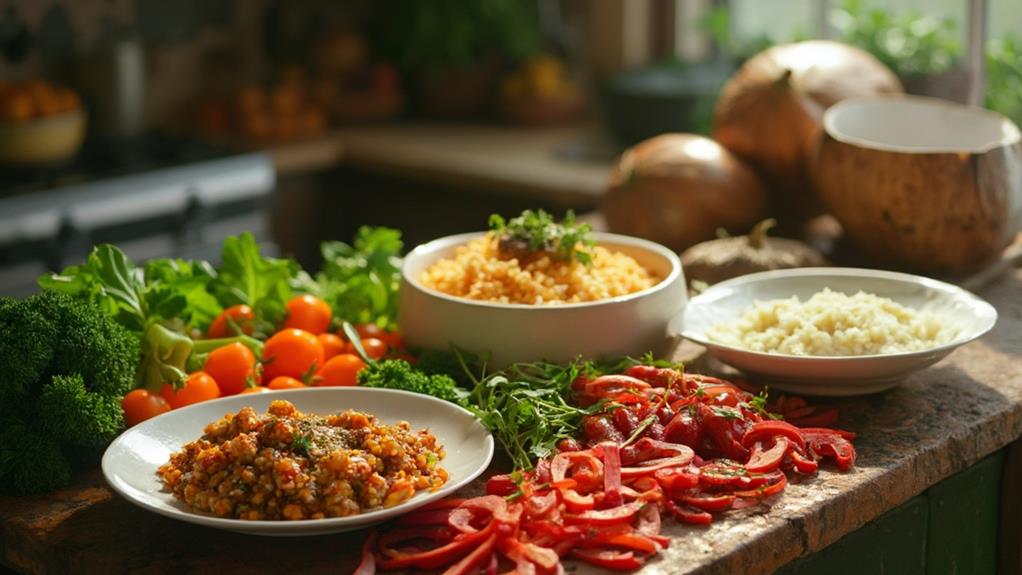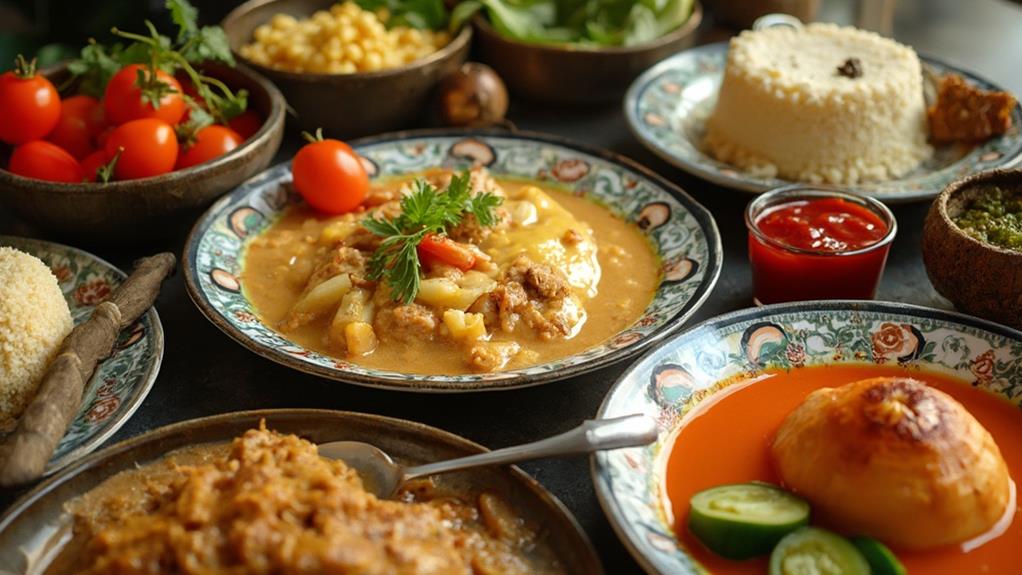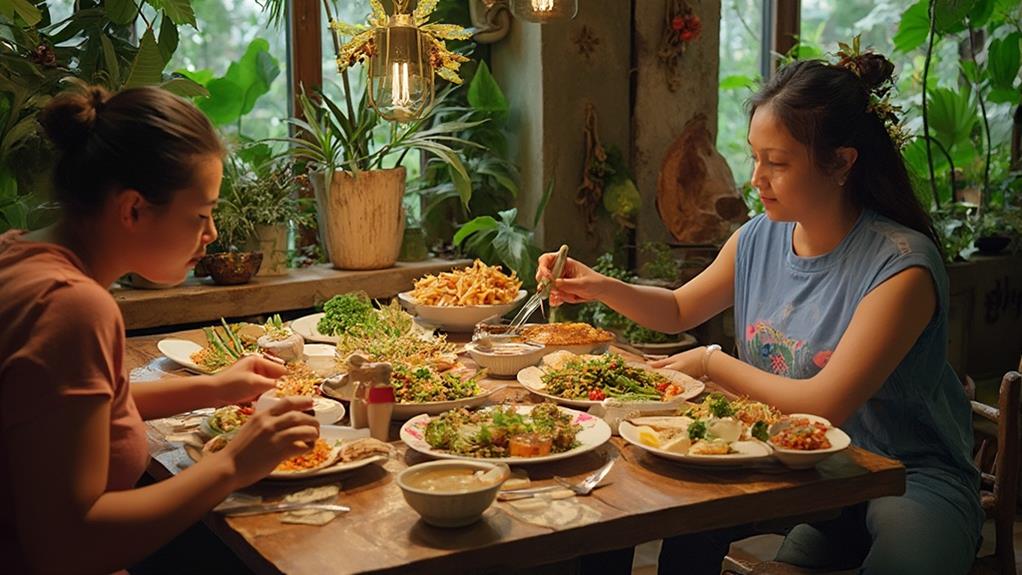Filipino Cuisine and Common Allergens
Peanuts, seafood, dairy, and gluten are common allergens found in Filipino dishes. These ingredients are often used in popular dishes like kare-kare and sinigang, which can pose risks for individuals with food allergies.
Safe Substitutes for Common Allergens
To enjoy traditional Filipino flavors safely, substitute coconut milk for dairy and use rice instead of gluten. These alternatives allow individuals with dairy and gluten intolerance to savor the rich tastes of Filipino food without compromising their health.
Dining Out with Food Allergies
When dining out, always communicate your dietary needs to ensure your safety. Look for restaurants that understand and can accommodate allergy concerns. This proactive approach enables individuals with food allergies to enjoy Filipino cuisine without risking their health.
Prioritizing Health and Safety
By knowing which dishes to avoid and finding safe alternatives, individuals with food allergies can still enjoy the rich tastes of Filipino food without compromising their health.
Common Food Allergens in the Philippines
Common Food Allergens in the Philippines
Peanuts and Tree Nuts
Peanuts and tree nuts are common allergens in the Philippines. Peanuts are often used in Filipino dishes like kare-kare and various snacks, while tree nuts like cashews and almonds are frequently found in desserts and as toppings.
Dairy
Dairy allergies are also a concern, particularly in dishes that use milk or cheese. Filipino recipes often include dairy products, making it crucial to be aware of these ingredients.
Eggs
Eggs are a common ingredient in many Filipino recipes. They are often used in breakfast items like tortang talong and baked goods, making it essential to identify them in food products.
Wheat and Gluten
Wheat, found in products like pancit and various pastries, can trigger reactions for those with gluten sensitivity. Gluten-free alternatives are essential for individuals with gluten intolerance or sensitivity.
Seafood Allergies and Filipino Dishes
Seafood allergies pose a significant challenge in the Philippines, where seafood is a staple in many traditional dishes. This is particularly concerning for individuals with seafood allergies, as they need to be aware of the potential risks when consuming Filipino cuisine.
Common seafood allergens and related dishes include:
| Seafood Allergen | Common Dishes |
|---|---|
| Shrimp | Sinigang na Hipon |
| Squid | Adobong Pusit |
| Fish | Kinilaw |
| Crabs | Crab Rice |
Communicating dietary restrictions is crucial when dining out or attending gatherings. Individuals with seafood allergies should inform their hosts or servers about their restrictions to ensure their safety. Filipino cuisine can be adapted to suit their needs by substituting seafood with chicken or vegetables in recipes. Always read labels and ask about ingredients to guarantee safety while enjoying Filipino dishes.
Awareness and communication are key to savoring Filipino cuisine without compromising health. By being informed and proactive, individuals with seafood allergies can enjoy the rich flavors of Filipino dishes while protecting their well-being.
Nut Allergies: Risks and Alternatives

Nut Allergies: Risks and Alternatives
In Filipino cuisine, nut allergies pose a significant threat to individuals with sensitivities. Nuts, commonly used in dishes like kare-kare and various desserts, can trigger severe reactions.
Cross-contamination can occur easily in kitchens that prepare multiple dishes, making it crucial to recognize the risks associated with nut consumption.
To ensure a safe dining experience, it's essential to be aware of nut allergies and take necessary precautions.
Always read labels carefully and communicate your dietary restrictions when dining out or attending gatherings.
Fortunately, there are alternatives to nuts that can provide similar textures and nutritional profiles:
Seeds: Sunflower or pumpkin seeds can replace nuts in many recipes, offering a similar crunch and nutritional profile without the allergens.
Coconut: This versatile ingredient can substitute nuts in many recipes, providing a rich flavor and texture.
Legumes: While not a direct substitute, beans and lentils can enhance the protein content of your meals.
Gluten Intolerance and Local Staples
Filipino staples offer gluten-free options
Many traditional Filipino staples, such as rice and root vegetables, are naturally gluten-free, making them excellent choices for those with gluten intolerance.
Rice, the cornerstone of Filipino dining, is versatile and can be enjoyed in various forms, including steamed, fried, or as part of flavorful dishes like sinigang or adobo.
Be cautious with sauces and marinades
However, certain dishes may feature sauces or marinades that contain soy sauce or other gluten-containing ingredients, which can lead to unexpected gluten exposure.
When dining out, always ask about the ingredients and don't hesitate to request gluten-free alternatives.
Explore gluten-free local snacks
Many traditional street foods, such as bibingka (rice cake) or puto (steamed rice cake), can be made gluten-free, especially if you opt for recipes that use rice flour.
Enjoy Filipino cuisine without compromising health
By focusing on fresh, whole ingredients and communicating your dietary needs, you can enjoy the rich flavors of Filipino cuisine without compromising your health.
Your culinary journey can still be vibrant and fulfilling – without gluten.
Dairy Intolerance in Filipino Cuisine

Dairy intolerance affects a significant number of individuals, making it essential to navigate Filipino cuisine with caution. Traditional Filipino dishes often incorporate dairy products, which can be challenging for those who need to avoid them.
Common dairy products in Filipino cuisine:
Evaporated milk is often used in desserts like leche flan and savory dishes like ginataang bilo-bilo.
Condensed milk is frequently added to sweet treats such as halo-halo and other desserts.
Cheese is used as toppings for popular dishes like bibingka or served with various snacks, making it a hidden source of dairy.
Fortunately, many Filipino dishes are naturally dairy-free, allowing individuals with dairy intolerance to enjoy the rich flavors without compromising their health.
Coconut milk can be used as a creamy substitute in soups and desserts.
Nut-based milk and soy milk can also provide the richness needed in recipes.
Cross-Contamination Risks in Cooking
Cross-contamination risks in cooking: A significant threat to food safety
When preparing meals, cross-contamination can have severe consequences for individuals with food allergies. This occurs when allergens unintentionally mix with non-allergenic foods, leading to potentially life-threatening reactions.
Thorough cleaning is essential
To minimize cross-contamination, thoroughly clean surfaces and utensils before cooking. This includes washing hands, countertops, and equipment with soap and warm water.
Use separate cutting boards for allergenic and non-allergenic ingredients to prevent accidental mixing. For example, if you're handling shrimp for a dish, ensure that the board and knife you're using haven't been in contact with peanuts or other allergens.
Frying and grilling require caution
Be cautious with frying and grilling, as oil used for frying allergenic foods can retain traces of those allergens.
Use fresh oil or dedicate specific equipment for allergenic items to prevent cross-contamination.
Proper food storage is crucial
Store food properly to prevent cross-contamination.
Label containers clearly and keep allergenic foods sealed and separate from others in the refrigerator. This ensures that allergens aren't accidentally introduced into non-allergenic foods.
Communication is key
Always communicate with others in the kitchen about your food allergy concerns to foster a safer cooking experience.
How Can Traditional Filipino Medicine Help with Food Allergies and Intolerances in Filipino Cuisine?
Traditional filipino medicine & wellness offers natural remedies for food allergies and intolerances found in Filipino cuisine. Herbs like ginger, turmeric, and calamansi are known for their anti-inflammatory and digestive properties, providing relief from symptoms. Acupuncture and massage therapy are also used to promote overall wellness and improve digestion.
Identifying Safe Dining Options

Finding safe dining options is crucial for anyone with food allergies, especially in a diverse culinary landscape like Filipino cuisine.
To ensure a safe dining experience, consider the following strategies:
Research Restaurants: Look for establishments with clearly labeled menus and a willingness to accommodate dietary restrictions.
Check online reviews to gauge their allergy awareness. This helps identify restaurants that can provide a safe dining experience.
Ask Questions: Communicate your allergies to the staff and inquire about food preparation, including the possibility of cross-contamination.
Knowledgeable staff will appreciate your proactive approach and can provide guidance on safe options.
Opt for Simplicity: Choose dishes with fewer ingredients to minimize the risk of hidden allergens.
Simple grilled meats or vegetable dishes often have less potential for cross-contact with allergens. This reduces the likelihood of an allergic reaction.
Traditional Dishes to Avoid
Traditional Filipino Dishes to Avoid with Food Allergies
Some traditional Filipino dishes can be hazardous for individuals with food allergies.
Kare-kare, a peanut stew, can trigger severe reactions in those allergic to nuts.
Similarly, lumpiang shanghai, a fried spring roll, may contain allergens like soy sauce or shellfish, depending on the recipe.
Seafood Allergies and Filipino Soups
Sinigang, a sour soup, sometimes includes shrimp or fish, which can be problematic for those with seafood allergies.
Additionally, lechon, the famous roasted pig, may be marinated in ingredients that contain allergens like soy or garlic, leading to potential complications.
Desserts with Hidden Allergens
Halo-halo, a popular mixed dessert, often contains ingredients like beans, jellies, and dairy, which can be problematic for those with specific intolerances.
Understanding these risks can help you make informed decisions when navigating Filipino cuisine.
Always ask about ingredients and preparation methods to ensure your safety while enjoying the vibrant flavors that Filipino food has to offer.
Tips for Safe Eating Out

Eating out requires careful planning and communication for those with food allergies. To ensure a safe dining experience, follow these tips:
Research the Restaurant: Look up menus online to identify allergy-friendly options. Many restaurants now highlight allergens on their menus, making it easier to choose safe dishes.
For example, if you're allergic to gluten, look for restaurants that offer gluten-free bread or pasta options.
Communicate Clearly: Inform your server about your allergies when you arrive.
Be specific about your allergies and ask questions about ingredients and preparation methods. For instance, if you're allergic to peanuts, ask if the chef uses peanut oil in cooking.
Be Cautious with Cross-Contamination: Even if a dish seems safe, cross-contact with allergens can occur during cooking or serving.
Ask how the food is prepared and if the chef takes steps to prevent cross-contamination. For example, if you're allergic to shellfish, ask if the chef uses separate utensils and cooking surfaces to prepare shellfish dishes.
